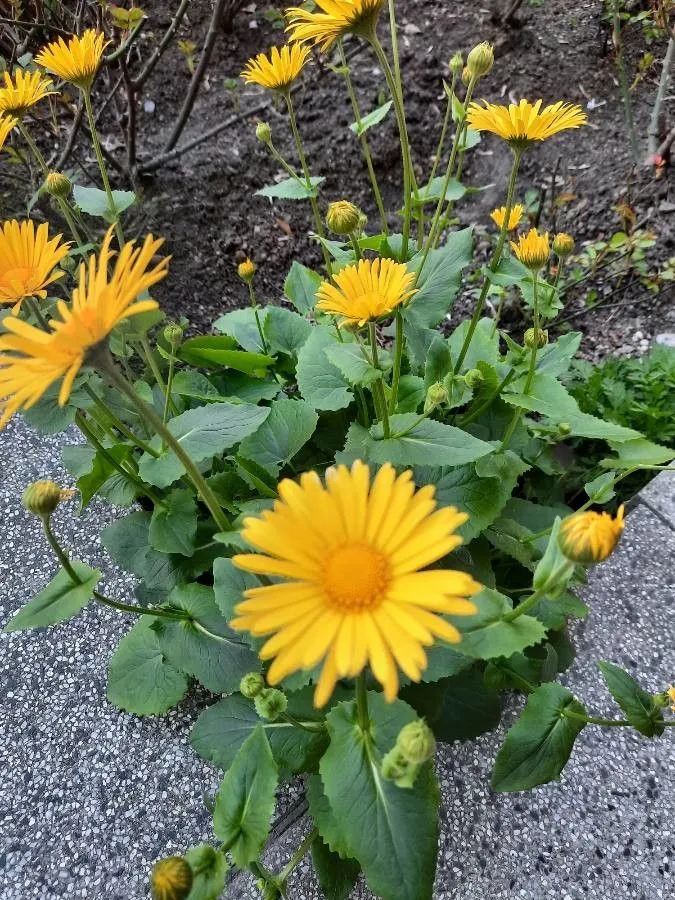
Author: L.
Bibliography: Sp. Pl.: 885 (1753)
Year: 1753
Status: accepted
Rank: species
Genus: Doronicum
Vegetable: Unknown
Observations: W. & S. Europe
Plantain-leaf leopard’s-bane, known scientifically as Doronicum plantagineum, is an enchanting and resilient perennial belonging to the Asteraceae family. This distinguished botanical species was first described by the renowned botanist Carl Linnaeus in 1753, under the systematic work “Species Plantarum.”
Native to the broad sweep of Western and Southern Europe, Plantain-leaf leopard’s-bane thrives in temperate climates, flourishing in a variety of habitats ranging from woodland clearings to the verdant meadows of the European countryside. This plant is particularly beloved for its striking appearance and its robust nature, making it a favored selection among gardeners and naturalists alike.
The plant gets its name from the distinctive broad, oval leaves that resemble those of the plantain, coupled with the radiant yellow flowers that mark the leopard’s-bane genus. These flowers bloom in daisy-like composites, typically from late spring into early summer. Each flower head is a vibrant display composed of numerous bright-yellow petals encircling a central disc, which serves as a beacon for pollinators.
In addition to its ornamental appeal, Doronicum plantagineum plays a vital role within its ecosystem. By attracting a diverse range of pollinators, such as bees and butterflies, it contributes to the health and biodiversity of the flora around it. Despite its beauty, it’s important to note that many parts of this plant are toxic if ingested, a characteristic that should be considered when planting in areas frequented by pets or small children.
Gardening enthusiasts appreciate Plantain-leaf leopard’s-bane for its ease of cultivation. Preferring moist, well-drained soil and partial shade, it is adaptable to various garden settings. When planted en masse, it provides a stunning ground cover that helps suppress weeds, while also serving as an excellent companion to other shade-loving plants.
Doronicum plantagineum endures as a testament to the captivating diversity found within the Asteraceae family and remains a cherished element of the European flora. Its historical and ecological significance continues to be recognized by botanists and horticulturists worldwide, ensuring that its vibrant presence will be appreciated for generations to come.
Nor: dauvnesle, gulltvitann, mjuktvitann, vrangtvitann
Dan: døvnælde, guldnælde, liden tvetann, nyrebladet tvetann, vejbred-gemserod
Swe: gulplister, mellanplister, mjukplister, vitplister, stor gemsrot
Fin: keltapeippi, sepiväpeippi, valkopeippi, välipeippi
Isl: ljósatvítönn, mjúkatvítönn
Eng: plantain false leopardbane, plantain-leaved leopard’s-bane, plantain-leaf leopard’s-bane, leopard’s bane
Deu: schwindelwurz, wegerich-gämswurz
Nld: weegbreezonnebloem
Fra: doronic plantain, doronic à feuilles de plantain
Cym: llwynhidydd-ddail, llysiau’r llewpard, llysiau’r-llewpart dail llyriad
En: Plantain-leaf leopard’s-bane, Plantain false leopardbane, Plantain-leaved Leopard’s-bane, Leopard’s bane
Ar: درونق ربلي
Ca: Dorònic plantagini
Da: Døvnælde, Guldnælde, Liden Tvetann, Nyrebladet Tvetann, Vejbred-gemserod
Nl: Weegbreezonnebloem
Fi: Isovuohenjuuri, Keltapeippi, Sepiväpeippi, Valkopeippi, Välipeippi
Fr: Doronic plantain, Doronic à feuilles de plantain, Doronic faux plantain
De: Wegerich-Gämswurz, Schwindelwurz, Wegerichblättrige Gemswurz
Is: Ljósatvítönn, Mjúkatvítönn
Mk: Леопардов отров
No: Dauvnesle, Gulltvitann, Mjuktvitann, Vrangtvitann
Sv: Stor gemsrot, Gulplister, Mellanplister, Mjukplister, Vitplister
Cy: Llysiau‘r-llewpart dail llyriad, Llwynhidydd-Ddail, Llysiau’r Llewpard, Llysiau’r-Llewpart Dail Llyriad
Taken Mar 3, 2021 by Prieta Javier (cc-by-sa)
Taken May 9, 2021 by Patrick Grouiller (cc-by-sa)
Taken May 13, 2021 by angels augspach (cc-by-sa)
Taken Sep 28, 2019 by Raluca Cladoveanu (cc-by-sa)
Taken Apr 22, 2021 by Linda Scharingerova (cc-by-sa)
Taken May 18, 2021 by Ella (cc-by-sa)
Taken Apr 20, 2020 by Bourchy Bourchy Daniel (cc-by-sa)
Taken Aug 20, 2022 by Sarah Madusa Myers (cc-by-sa)
Taken May 5, 2022 by AbejaRuca Abeja (cc-by-sa)
Taken Mar 3, 2021 by Prieta Javier (cc-by-sa)
Taken Jun 26, 2022 by Manuëlle (cc-by-sa)
Taken May 18, 2021 by Ella (cc-by-sa)
Taken Jul 31, 2019 by matthieu thezan (cc-by-sa)
Taken Apr 20, 2021 by louis bregeat (cc-by-sa)
Taken Mar 3, 2021 by Prieta Javier (cc-by-sa)
Taken May 1, 2022 by Eszter Elek (cc-by-sa)
Taken Jan 1, 1970 by Photoflora – L’Abbé COSTE (©)
Taken Mar 15, 2017 by Photoflora – Benoit BOCK (©)
Taken Apr 30, 1874 by Tela Botanica − Herbier PONTARLIER-MARICHAL (cc-by-sa)
Taken Mar 11, 2021 by mohammad fazel dehkordi (cc-by-sa)
Taken May 13, 2022 by jacques maréchal (cc-by-sa)
Taken Sep 26, 2018 by Jean-Michel Faton (cc-by-sa)
Taken Jan 15, 1995 by Photoflora – Benoit BOCK (©)
Taken Jun 20, 2019 by MICHEL DUSSERE (cc-by-sa)
Taken May 30, 2021 by Rico Mende (cc-by-sa)
Taken Apr 26, 2015 by Tela Botanica − Emmanuel STRATMAINS (cc-by-sa)
Taken Apr 26, 2015 by Tela Botanica − Emmanuel STRATMAINS (cc-by-sa)
© copyright of the Board of Trustees of the Royal Botanic Gardens, Kew.
© copyright of the Board of Trustees of the Royal Botanic Gardens, Kew.
© copyright of the Board of Trustees of the Royal Botanic Gardens, Kew.
Family: Myrtaceae Author: (F.Muell.) K.D.Hill & L.A.S.Johnson Bibliography: Telopea 6: 402 (1995) Year: 1995 Status:…
Family: Rubiaceae Author: Pierre ex A.Froehner Bibliography: Notizbl. Bot. Gart. Berlin-Dahlem 1: 237 (1897) Year:…
Family: Sapindaceae Author: Koidz. Bibliography: J. Coll. Sci. Imp. Univ. Tokyo 32(1): 38 (1911) Year:…
Family: Asteraceae Author: A.Gray Bibliography: Pacif. Railr. Rep.: 107 (1857) Year: 1857 Status: accepted Rank:…
Family: Fabaceae Author: Medik. Bibliography: Vorles. Churpfälz. Phys.-Ökon. Ges. 2: 398 (1787) Year: 1787 Status:…
Family: Aspleniaceae Author: (Cav.) Alston Bibliography: Bull. Misc. Inform. Kew 1932: 309 (1932) Year: 1932…